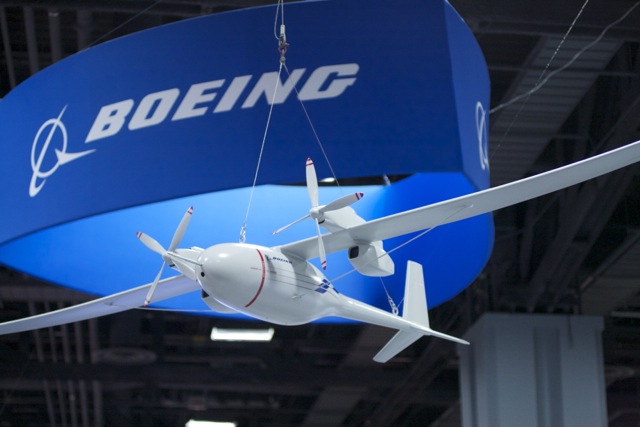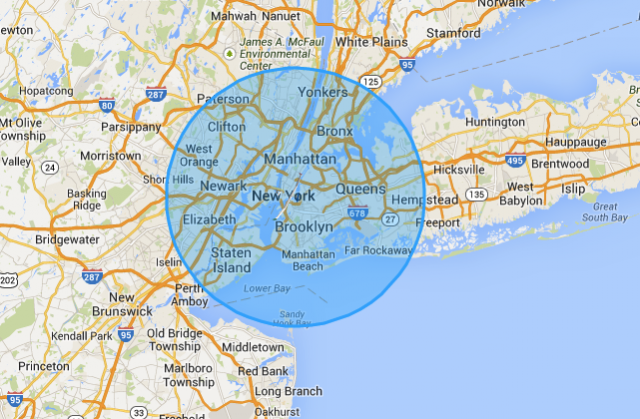Titan's Solara, first commercial solar drone, can fly five years without landing.

A model of the Solara 50, Titan Aerospace's commercial "atmospheric satellite," hangs above the company's booth at the AUVSI Unmanned Systems conference booth.
WASHINGTON—At the AUVSI Unmanned Systems conference, New Mexico-based startup Titan Aerospace unveiled the company's prototypes for "atmospheric satellites"—autonomous unmanned aircraft powered purely by solar energy and capable of staying aloft at high altitude for up to five years. The first commercially manufactured long-endurance solar drone, the Solara 50, is under construction now and is expected to fly next year. A bigger drone, the Solara 60, will soon follow.
While solar-powered flight has been a reality since the early 1980s, Titan is the first company to work on commercially manufacturing solar-powered drones. And unlike some of the prototypes that have been flown by the established players in the aerospace and unmanned systems field, the Solara drones are based on well-worn technologies and simplicity in design.
If successful, Titan could change the economics of businesses that have previously depended on low-orbit satellites and allow for a persistent coverage closer to what satellites in geostationary orbit provide.
On the wings of a penguin
Solar-powered flight has been a reality since AeroVironment took the lessons from the human-powered aircraft Gossamer Albatross—which flew across the English Channel in 1979—and applied them in the Gossamer Penguin and Solar Challenger aircraft in the early 1980s. But complexity and durability issues have dogged most efforts to create the holy grail of solar aircraft—a drone that can stay aloft indefinitely.
AeroVironment has built a number of solar-powered aircraft for the government, including the Helios prototype—a giant drone with a wingspan of 247 feet powered by solar panels and hydrogen fuel cells. The Helios crashed off of Hawaii in 2003 when it suffered structural failure due to turbulence.
The early success of Helios partially inspired the Defense Advanced Research Projects Agency (DARPA) and Boeing's "Vulture" program in 2008, an effort to create a drone that could spend up to five years on station at 60,000 to 90,000 feet with a thousand-pound payload. Qinetq's Zephyr, one of the program's competitors, flew for 336 hours and 22 minutes, setting the endurance record for unmanned aircraft—but it set the record after DARPA cut the funding for the Boeing contract and reduced the program's scope to work on solar cells and energy storage systems.
That didn't end the Defense Department's appetite for long-flying drones. But the alternative paths chosen so far haven’t paid off. Another AeroVironment aircraft, the Global Observer—a purely hydrogen-powered drone with a 70-foot wingspan designed for week-long missions—crashed in 2011, resulting in the termination of the program by the Pentagon. Boeing has its own hydrogen-powered, long-endurance drone, the Phantom Eye, in development; so far its longest flight has been just over two hours.

A model of Boeing's Phantom Eye at Boeing's AUVSA conference booth.
Almost orbital
Titan's aircraft plans are more modest and much more ambitious at the same time. Solara 50 will have a payload of just 70 pounds—though depending on the time of year and location of the flight, longer daylight hours could sustain flights with heavier payloads. The next design, the Solara 60, will carry up to 250 pounds. Instead of using hydrogen fuel cells, the Solara aircraft use batteries charged from solar panels to power flight at night and provide about 100 watts of power to the aircraft's payload as well.
The Solara 50 has a 50 m (164 feet) wingspan. The upper surfaces of its wings and tail are packed with over 3,000 photovoltaic cells capable of generating up to 7 kilowatts. It is launched by catapult and can land (when it has to) by skidding on its Kevlar-coated underside. Unlike the giant flying-wing configurations of the Helios and Zephyr, which had large numbers of propellers, the Solara has a single, high-efficiency motor.
In theory, a solar-powered drone capable of withstanding long flights at high altitude—in what Titan executives call the "sweet spot" in the Earth's atmosphere between 60,000 and 70,000 feet, above nearly all weather patterns in a zone where winds are typically less than 5 knots (5.75 miles/hour)—would be able to perform tasks usually reserved for satellites at a much lower cost.
For example, during a presentation by Titan at AVUSA, a company spokesperson compared using a satellite for multispectral Earth imagery—say, like Landsat's—to using an atmospheric satellite. A drone could be put up quickly, for much less initial capital. At the same time, it would provide targeted imagery at a cost of less than $5 per square kilometer—versus $35 per square kilometer from a satellite—while still offering the large area of coverage of a satellite.

Enlarge / Artist's rendering of Solara 50 at high altitude.
Titan Aerospace
Enlarge / The coverage area of a Solara 50, superimposed over New York.
As a communications relay, the Solara offers about an 18-mile radius of coverage—easily covering all of New York City's five boroughs, as shown in the map above. A "constellation" of Solara craft could create a persistent communication network for disaster relief efforts or could provide long-term services, such as Google's planned air-based broadband in areas without existing telecommunications infrastructure. The search giant is planning to deploy Solara drones as part of the Internet Africa Project.
Titan already has customer reservations for the first three of its Solara drones, two of which are intended to serve as communications relays (though the customer has not been identified). The first will be delivered in February, with manufacturing ramping up for monthly delivery starting in April.
by Sean Gallagher - Aug 18 2013, 8:00pm PM

A model of the Solara 50, Titan Aerospace's commercial "atmospheric satellite," hangs above the company's booth at the AUVSI Unmanned Systems conference booth.
WASHINGTON—At the AUVSI Unmanned Systems conference, New Mexico-based startup Titan Aerospace unveiled the company's prototypes for "atmospheric satellites"—autonomous unmanned aircraft powered purely by solar energy and capable of staying aloft at high altitude for up to five years. The first commercially manufactured long-endurance solar drone, the Solara 50, is under construction now and is expected to fly next year. A bigger drone, the Solara 60, will soon follow.
While solar-powered flight has been a reality since the early 1980s, Titan is the first company to work on commercially manufacturing solar-powered drones. And unlike some of the prototypes that have been flown by the established players in the aerospace and unmanned systems field, the Solara drones are based on well-worn technologies and simplicity in design.
If successful, Titan could change the economics of businesses that have previously depended on low-orbit satellites and allow for a persistent coverage closer to what satellites in geostationary orbit provide.
On the wings of a penguin
Solar-powered flight has been a reality since AeroVironment took the lessons from the human-powered aircraft Gossamer Albatross—which flew across the English Channel in 1979—and applied them in the Gossamer Penguin and Solar Challenger aircraft in the early 1980s. But complexity and durability issues have dogged most efforts to create the holy grail of solar aircraft—a drone that can stay aloft indefinitely.
AeroVironment has built a number of solar-powered aircraft for the government, including the Helios prototype—a giant drone with a wingspan of 247 feet powered by solar panels and hydrogen fuel cells. The Helios crashed off of Hawaii in 2003 when it suffered structural failure due to turbulence.
The early success of Helios partially inspired the Defense Advanced Research Projects Agency (DARPA) and Boeing's "Vulture" program in 2008, an effort to create a drone that could spend up to five years on station at 60,000 to 90,000 feet with a thousand-pound payload. Qinetq's Zephyr, one of the program's competitors, flew for 336 hours and 22 minutes, setting the endurance record for unmanned aircraft—but it set the record after DARPA cut the funding for the Boeing contract and reduced the program's scope to work on solar cells and energy storage systems.
That didn't end the Defense Department's appetite for long-flying drones. But the alternative paths chosen so far haven’t paid off. Another AeroVironment aircraft, the Global Observer—a purely hydrogen-powered drone with a 70-foot wingspan designed for week-long missions—crashed in 2011, resulting in the termination of the program by the Pentagon. Boeing has its own hydrogen-powered, long-endurance drone, the Phantom Eye, in development; so far its longest flight has been just over two hours.

A model of Boeing's Phantom Eye at Boeing's AUVSA conference booth.
Almost orbital
Titan's aircraft plans are more modest and much more ambitious at the same time. Solara 50 will have a payload of just 70 pounds—though depending on the time of year and location of the flight, longer daylight hours could sustain flights with heavier payloads. The next design, the Solara 60, will carry up to 250 pounds. Instead of using hydrogen fuel cells, the Solara aircraft use batteries charged from solar panels to power flight at night and provide about 100 watts of power to the aircraft's payload as well.
The Solara 50 has a 50 m (164 feet) wingspan. The upper surfaces of its wings and tail are packed with over 3,000 photovoltaic cells capable of generating up to 7 kilowatts. It is launched by catapult and can land (when it has to) by skidding on its Kevlar-coated underside. Unlike the giant flying-wing configurations of the Helios and Zephyr, which had large numbers of propellers, the Solara has a single, high-efficiency motor.
In theory, a solar-powered drone capable of withstanding long flights at high altitude—in what Titan executives call the "sweet spot" in the Earth's atmosphere between 60,000 and 70,000 feet, above nearly all weather patterns in a zone where winds are typically less than 5 knots (5.75 miles/hour)—would be able to perform tasks usually reserved for satellites at a much lower cost.
For example, during a presentation by Titan at AVUSA, a company spokesperson compared using a satellite for multispectral Earth imagery—say, like Landsat's—to using an atmospheric satellite. A drone could be put up quickly, for much less initial capital. At the same time, it would provide targeted imagery at a cost of less than $5 per square kilometer—versus $35 per square kilometer from a satellite—while still offering the large area of coverage of a satellite.

Enlarge / Artist's rendering of Solara 50 at high altitude.
Titan Aerospace

Enlarge / The coverage area of a Solara 50, superimposed over New York.
As a communications relay, the Solara offers about an 18-mile radius of coverage—easily covering all of New York City's five boroughs, as shown in the map above. A "constellation" of Solara craft could create a persistent communication network for disaster relief efforts or could provide long-term services, such as Google's planned air-based broadband in areas without existing telecommunications infrastructure. The search giant is planning to deploy Solara drones as part of the Internet Africa Project.
Titan already has customer reservations for the first three of its Solara drones, two of which are intended to serve as communications relays (though the customer has not been identified). The first will be delivered in February, with manufacturing ramping up for monthly delivery starting in April.
by Sean Gallagher - Aug 18 2013, 8:00pm PM

Aucun commentaire:
Enregistrer un commentaire